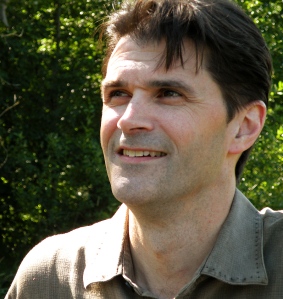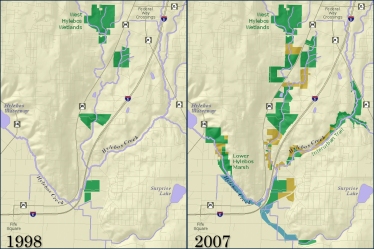
Chris Carrel is a life-long resident of the Hylebos Creek watershed. For many years, he headed Friends of the Hylebos, and led efforts to restore the damaged creek.
For decades, residential and industrial development has degraded the habitat that the Salish Sea’s iconic salmon need to survive. The listing of many salmon runs as threatened or endangered drew attention – and money – to efforts to restore damaged rivers and creeks.
This week Liam Moriarty tours Lower Hylebos Marsh with Chris Carrel. Carrel grew up in the watershed that drains into Tacoma’s Commencement Bay and for years he led efforts to bring the creek back to life.
Click to listen to the story
Liam Moriarty: One of the things that strikes me about being here is that I’m hearing all these natural sounds. I’m hearing the creek. I’m hearing the wind in the trees. I’m hearing birds. At the same time, there’s this constant overlay of aircraft and machinery and sirens and trucks going by and things. You’re very aware that this is not a pristine area. This is a place that is on the edge of a major industrial zone.
Chris Carrel: Yeah; due to the restoration project that was created here, we’ve created a little pocket of nature right next to a busy industrial port.
Liam: Let’s get real basic. This is about restoring salmon.
Chris: Yeah.
Liam: Talk about that.
| http://xanmccallum.com |
Chris: The Hylebos Creek, back when I was a kid, back, say, in the early 1970s, was one of the most productive small salmon streams in the central Puget Sound region. I used to watch the returning salmon runs – coho salmon, chum salmon – we even had chinook salmon – and it was incredible. Here was this fairly small creek and we’d see these huge fish coming back. I remember as a kid just being astounded at seeing these wild fish returning from the ocean and coming back to the place where I lived.
Liam: Show me around.
Chris: Sure. This is a long term process, obviously. We’re trying to create something that’s going to be mature in 70, 100, 150 years so we’re just seeing it in its infancy. The wildlife has come back. It’s being used by wildlife.
Liam: We saw some rabbits scooting across the trail just a moment ago.
Chris: Yeah; there are surely coyotes out here as well, following them.
Liam: They did seem to be in a hurry.(laughter)
Chris: Do you mind popping down through the trees?

Chris Carrel standing on a wooden bridge crossing Hylebos Creek. The area on the left has been restored to a more natural state.
Liam: No; sure.
Chris: We can see the marsh?
Liam: Lead on.
Chris: Obviously, nobody’s been back here.
Liam: (laughs) We’re kind of bushwhacking a little here.
This is getting pretty marshy through here.
Chris: Yeah.
Liam: There we go; a little pond. What function does this perform?
What is it that a pond like this off the main channel of the creek – what does that do?
Chris: Off channel habitat is very important for juvenile salmon. It provides them a place to forage; to get out of the mainstream and get away from predators. It gives them a chance to grow a little bit bigger which increases their chances of survival.
One of the cool things that happened here; I was out here on a site tour with some folks, and we were busting through the trees like you and I just did, and then we came through the trees and the water level was much higher than it should have been. We kind of did the, what’s going on here; something’s not right.
What we discovered was beavers had –
Liam: Beavers! I knew that was coming. (laughter)
Chris: I know some people are not happy when beavers move in. We were delighted. Beavers are a really important part of creek systems like this. They provide great habitat for juvenile salmon and really, they would enhance the work that’s already been done here.
We kind of set the plate for them and they came in and refined our work. The beavers have since moved on but it gives me hope that we’ll see beavers come back again.
Liam: You know, this is not the wilderness; clearly. This is on the edge of a fairly busy industrial area. Does it make sense to put this much effort and this much money into trying to restore places that are so far gone, that are that urbanized?

Left shows the preserved property in 1998 (prior to the mission change of the FOH). The right shows total preserved (green), identified as potential acquisitions (yellow), and the WSDOT SR167 highway project preservation/restoration area (blue)
Chris: There’s a debate about whether it’s wise to invest in preservation or restoration of places like this. There are some people who look at that and say Hylebos is toast. We shouldn’t invest any money there. It makes more sense to invest in more pristine watersheds – the Skagit, the Nisqually – you know – places where we know we can save them before they get to what Hylebos Creek looks like.
But I always come back to the fact that this is where the people are. We’ve got to show people that nature can exist in their backyards where they live. Because when times get tough, and times are tough right now, it’s the people that we’re going to have to go back to and say we need you to support this. If they don’t have a reason to support places like the Lower Hylebos Marsh, we could lose a lot more.


